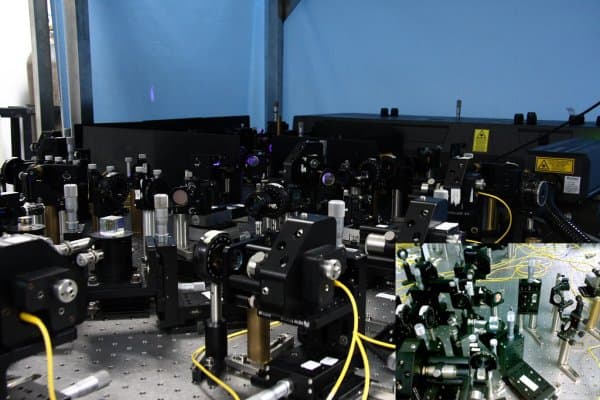
Researchers in China and Europe have entangled a record-breaking 10 quantum bits — an important breakthrough in the quest to develop practical quantum computers.
The quantum bits (qubits) were in a “Schrödinger’s cat state”, so-called because the state has an equal probability of having one of two extreme values until a measurement is made on it. The state is much like the cat of Erwin Schrödinger’s famous thought experiment, which is both dead and alive until a quantum measurement seals its fate.
Qubits are the basis for storing and processing information in quantum computers, which could someday perform parallel calculations on a massive scale. A qubit could be the polarization state of a photon, for example, with “1” corresponding to horizontal polarization and “0” to vertical polarization. If two photons are entangled, a measurement of the polarization of one photon would automatically reveal the polarization of the other.
Particles such as a photons can also be entangled simultaneously in terms of several different properties in a process dubbed “hyper entanglement”. This can be achieved, for example, by simply passing a polarization-entangled photon through a polarizing beam splitter — a device that deflects vertically polarized light in one direction (say “left”) and horizontally polarized in another direction (say “right”).
Until the position of the photon is measured, it will be in an entangled state of a photon that has been deflected “left” by the beam splitter and one that has been deflected “right”. And a measurement on the position of this photon will reveal the polarization of its entangled partner.
However, single-photon qubits are very difficult to manipulate and physicists have yet to build a practical device that can perform calculations using large numbers of entangled qubits.
Now, Jian-Wei Pan and colleagues at Germany’s University of Heidelberg claim to have boosted the number of entangled qubits to ten — up from the previous record of eight. The team also included physicists from University of Science and Technology of China in Hefei and the University of Innsbruck in Austria (arXiv:0809.4277v1).
Entangled pairs
The experiment involves shining pulses of infrared laser light through a crystal of lithium triborate (LBO), which shifts some of the light to ultraviolet frequencies. The ultraviolet light is then passed through two successive beta–barium borate (BBO) crystals, which very occasionally produce two pairs of infrared photons (one pair from each crystal). The photons in each pair are entangled in terms of polarization.
One photon from each pair is then sent to a polarizing beam-splitter, which entangles the two photons. This means that all four photons produced in the BBO are entangled with each other. One of these photons is then entangled in a polarizing beam splitter with a fifth photon from the original infrared beam.
The result of this is five entangled photons. Furthermore, if one photon is measured to have a vertical polarization, the other four will all be vertically polarized, while if one has a horizontal polarization so will all the others. These two extreme polarization states are indistinguishable until a measurement is made and therefore the five photons are in a “Schrödinger’s cat state”.
The next step is to send each of the five photons through a differently polarized beam splitter, which splits each photon into two possible spatial states. The result is a hyper-entangled 10 qubit state — the largest yet to be entangled.
High-fidelity entanglement
The team confirmed this by measuring the position and polarization of the photons and determined that the qubits were entangled at a fidelity of about 0.56. According to the team, a value greater than 0.5 means that entanglement has been achieved,.
While this 10 qubit entanglement is impressive, Schrödinger cat states are not very useful for practical applications because they are easily destroyed — the problem is that an accidental measurement of one qubit reveals the value of all the other qubits.
A more robust route to multi-qubit entanglement is the “graph state”, in which the entanglement is engineered such that an accidental measurement of one qubit would only reveal the value of a subset of other qubits and leave the others entangled.
While Pan and colleagues have not entangled graph states, they have proposed several ways that their scheme could be extended to do so.


